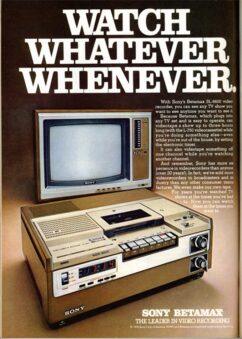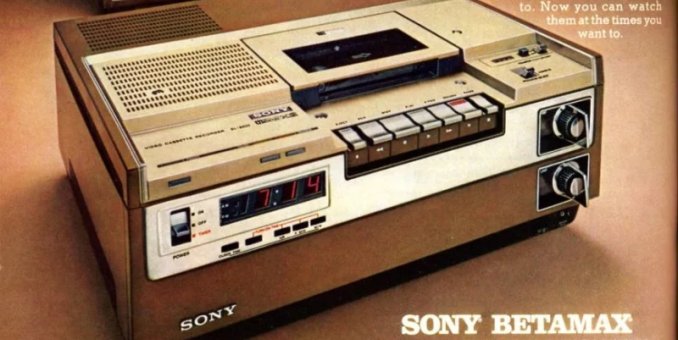In these days of streaming and digital video recorders, giving one access to a wealth of entertainment options at the click of a mouse or remote control is taken for granted. Of course, it was not always like that. Up until a few decades ago, television viewers were pretty much at the mercy of the television schedule. You only had a few choices between whatever your local network-affiliated stations were broadcasting at that time. If there was nothing of interest to you on? Tough luck, maybe go read a book. Wanted to watch that episode of Columbo, but were not able to be in front of your set when it aired? Too bad, maybe you’ll get lucky and it will be rerun over the summer.
It wouldn’t be until the advent of the consumer grade video cassette recorder in the mid-1970s that people would be able to record television broadcasts to watch later at their leisure where we would start to see a shift in how people would watch television. That shift, however, almost didn’t happen. And it was the Supreme Court that would ultimately clear the way in a decision delivered forty years ago on this date, January 17, 1984.
Sony Corp. of America v. Universal City Studios, Inc.
 The idea of recording video signals on magnetic tape in a manner similar to how audio signals could be was first suggested in 1950, by crooner Bing Crosby of all people. However, it would take over a decade of research and development by a number of different companies before the first video recording and playback machines were available. Their price was prohibitively expensive for the consumer market, but they were quickly adapted by the television industry for ease of use and lower cost than committing everything to film. But consumer-level video tape machines weren’t far behind, with the very first becoming available in the early 1970s.
The idea of recording video signals on magnetic tape in a manner similar to how audio signals could be was first suggested in 1950, by crooner Bing Crosby of all people. However, it would take over a decade of research and development by a number of different companies before the first video recording and playback machines were available. Their price was prohibitively expensive for the consumer market, but they were quickly adapted by the television industry for ease of use and lower cost than committing everything to film. But consumer-level video tape machines weren’t far behind, with the very first becoming available in the early 1970s.
Sony’s entry into this new field of consumer home electronics was the Betamax video cassette recorder. Through the use of video tape cassettes, users were suddenly in command as to when they could watch their favorite televised programs and sports events. It was an ability that company even touted in their advertising. They could pause things at any point for a snack or bathroom break. They could even fast forward over commercials if they wanted to. The Betamax was soon followed into the commercial arena by a number of other companies with their own video tape recorders/players. And the studios did not like that.
In the late 1970s, the record industry was going through a panic over the existence of blank audio cassette tapes and their potential for being used to record music off the radio, leading to a loss of income. The studios were perceiving a similar threat from blank video tape cassettes and giving people the ability to record televised programming off the air, an act which they saw as constituting copyright infringement.
In 1976, Universal and Disney teamed up to launch a lawsuit against Sony in the U.S. District Court for the Central District of California, arguing that since the company was manufacturing a device that could be used for copyright infringement, it was in part liable for all infringement that is performed by anyone who has done so with one of their machines. Interestingly enough, childrens broadcaster Fred Rogers, aka Mr. Rogers, testified on Sony’s behalf in part saying that many television producers were perfectly fine with letting private recording for time-shifted viewing to continue. The court ruled in Sony’s favor, stating that it found that time-shifting one’s viewing with a video tape recorder was not a violation of copyright and fell well within the purview of Fair Use.
Needless to say, Universal and Disney appealed that decision to the U.S. 9th Circuit Court of Appeals, which overturned the district court’s decision. The Court stated that it found that the main purpose of a Betamax machine was copying and held Sony liable for contributory copyright infringement. It further recommended an injunction against Sony that would have them cease the sales of Beatmax machines.
The Decision
Sony found itself in a tough position. It could accept the Circuit Court’s ruling or it could roll the dice and hope that an appeal to the Supreme Court would go there way. If they lost, they could be liable for millions in copyright infringement claims. But Sony went forward with its appeal to the Supreme Court and after two sessions of oral arguments, the Court rendered its decision.
On January 17, 1984, in a split ruling of 5 to 4, the Supreme Court found in favor of Sony, overruling the U.S. 9th Circuit Court of Appeals, and allowing for Sony to continue with manufacture and sales of their Betamax video recorder.
Writing for the majority opinion, Justice John Paul Stevens stated that the practice of consumers taping television programs for the purpose of watching them later did not constitute copyright infringement, but instead did fall under Fair Use provisions in copyright law. Specifically –
[W]hen one considers the nature of a televised copyrighted audiovisual work… and that time-shifting merely enables a viewer to see such a work which he had been invited to witness in its entirety free of charge, the fact… that the entire work is reproduced… does not have its ordinary effect of militating against a finding of fair use.
Furthermore, Stevens wrote that if a product had a substantial legitimate use, its sale could not be banned because of a potential secondary, unintended illegal use. In other words, since the designed purpose of a VCR is for recording programs for personal use, the device could not be outlawed because of a few people using it to copy and then rent or resell television programs or movies.
Aftermath
Needless to say, the studios were not happy with losing after fighting this case through the courts for eight years. Turning from the Judicial to the Legislative branch of the government, they began to lobby Congress to pass some new laws for the protections they were seeking. Congress, for its part, saw that the toothpaste was already out of the tube in terms of the inroads that VCRs had been making into Americans’ homes and declined to act on the issue.
Ultimately, the studios realized that if you can’t beat them, join them. They opened up their libraries and began placing much of their film catalogs on tape for sale to both rental stores and directly to the consumer. Many films that did not fare well at the box office upon their initial theatrical runs found new audiences while the studios were finding new revenue streams thanks to these home video releases. It helped people discover early installments of a franchise, and helped to drive them to theaters when a new installment would be released. The home video boom of the 1980s and 90s would be a boon for all.
But specifically for Sony, the win was somewhat bittersweet. Since the company decided to keep the specific technology of their recorder/players exclusively to themselves, Sony would ultimately loose out in their format war with VHS video cassette recorders. Sales of Betamax players plunged compared to VHS players, which shared compatibility in cassette technology regardless of the manufacturer. Eventually Sony discontinued their Betamax line and joined in making units that were compatible with VHS. Surprisingly, when two competing formats for high definition home video discs were introduced in the early 2000s, Sony used the same proprietary approach in promoting their Hi-Def DVD, but eventually were knocked out of the competition by the blu-ray disc.
And even our current streaming ecosystem owes its existence and its structure to the idea that people want to watch what they want to when they want. And that was an attitude bred into audiences by the ease of accessibility created by VCR and video store culture. And that was only possible thanks to the repercussions from the Supreme Court’s decision in Sony Corp. of America v. Universal City Studios.


